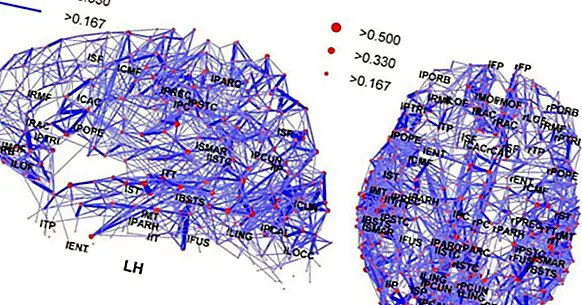Types of seizures: why do they occur and what causes them?
When we think of neurological disorders such as epilepsy, the first image that comes to most people's head is that of a person suffering from convulsions, sudden and violent contractions throughout the body that make him shake in a bed. hospital or on the ground.
Indeed, Seizures are one of the most visible and important symptoms of epilepsy (In fact, its diagnosis is made among other aspects if the subject has had several crises). But not all seizures are the same, nor do they occur only in epilepsy. In this article we will visualize the different types of seizures.
The convulsion: brief definition of the term
Seizures are understood to be those spasmodic movements of the voluntary skeletal muscles that occur abruptly, rhythmically, repetitively and totally involuntarily, with violent contractions of one or several muscle groups.
Seizures are a symptom of the existence of a brain problem that may have different origins . They usually have a short duration (usually up to two minutes), although longer episodes can be dangerous and are treated as emergencies. Its main cause is the existence of electrochemical imbalances in the brain, or a hyperexcitability of specific neuronal groups.
Types of seizures
As indicated above, not all seizures are the same, but different types can be established according to the affected brain area or areas, the level of muscle contraction or the causes of the seizure.
1. Classification according to the brain areas affected
According to whether the seizures are due to the alteration in a specific brain area or at a general level , we can consider the existence of two main groups of seizures.
1.1. Seizures of focal onset or partial seizures
It is the seizures due to the alteration of one or several regions of the brain well determined. The affected area will mark the type of symptoms that will be experienced. The seizure at motor level occurs in a specific part of the body, or even in a hemibody (that is, on one of the sides of the body).
They can be simple and complex, depending on whether there are alterations of consciousness (the latter being complex). There may be sensory alterations and perseveration of actions and gestures , and can even serve as a warning of the arrival of future generalized crises. It is also common for a focal crisis to become generalized, activating first brain areas and expanding to the rest of the brain later, these are called generalized secondary seizures.
1.2. Generalized seizures
Generalized seizures are those in which the whole or a large part of the brain is involved, with electrical alterations appearing in both hemispheres. They usually cause loss of consciousness and seizures of tonic-clonic type appear. They occur abruptly, although they can be preceded by an aura, and cause the patient to fall. It is common that there is loss of control of the sphincters, tongue bites and even torsions and muscle group injuries.
Within this subgroup can be found the absence crises (in which there can be slight contractions), the myoclonic, the tonic-clonic (being these the most representative) or even the atonic ones in which there is no seizure if not the loss of muscle tone after a contraction.
2. According to the level of muscular contraction
Another classification could be done depending on the level of intensity or the characteristics of the seizure itself. Among them, the following stand out.
2.1. Tonic seizures
It is a type of seizure in which there is a powerful muscular contraction of one of the muscles or of one or several muscle groups. There is a high level of stiffness in the muscle or muscles affected.
2.2. Clonic seizures
Clonic seizures are those that occur repetitively every two or three seconds, of short intensity and power.
2.3. Myoclonic seizures
Like the clonic ones, these are small muscle spasms of minimal duration, but they have as a consequence the involuntary movement of a part of the body.
2.4. Tonic-clonic seizures
The tonic-clonic convulsions are the most prototypical types of seizures, appearing both tonic and clonic seizures at the same time. It is the type of seizure that is part of the epileptic crisis of great evil.
2.5. Atonic crisis
In this type of crisis there are no real convulsions, but the abrupt disappearance of muscle tone. Sometimes this disappearance is preceded by a powerful muscular spasm.
3. According to the cause of seizures
Seizures can be produced by very different causes . It is important not to identify seizures with epilepsy because, although in this disorder they are very frequent, seizures may also occur due to other conditions. Some types are the following.
3.1. Epileptic seizures
Epilepsy is one of the main disorders that appear linked to the presence of seizures.
3.2. Febrile convulsions and infection
The presence of fevers higher than 39 degrees can provoke convulsive episodes without previous neurological alterations that explain them. They can be simple if they are not repeated and last less than fifteen minutes, or complex if there is recurrence of the episode in the first twenty-four hours (in which case they can also be called cluster or atypical seizures).
3.3. Seizures due to organic insufficiencies
The presence of alterations in the liver or kidneys can also generate the onset of convulsive episodes.
3.4. Seizures due to substance use
Both some medications and certain drugs can cause seizures, both as a side effect and during overdose, or during withdrawal syndromes.
3.5. Hysterical seizures
Seizures do not only arise from medical causes. Certain psychological disorders such as somatoforms cause the subject to suffer them. These types of seizures have the peculiarity that they usually occur only in the presence of others and not generate alterations in an electroencephalogram (although it is not fictitious symptoms, but generated psychologically).
3.6. Convulsions due to anxiety
In some situations of very high anxiety it is possible that motor and somatic alterations arise, being possible that seizures appear.



















